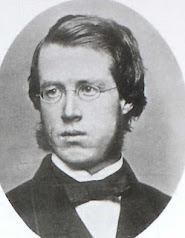The Rev. James Balloch Chase, who died at age 81 on the 9th of June, 1919, at Russell, left behind an amazing record as a pioneering cleric in Iowa and Nebraska. Credited with founding 23 churches and serving dozens of others as pastor, he arrived in Lucas County about 1914 where, although well past retirement age and not in the best of health, he accepted a call to serve the small Presbyterian congregation at LaGrange.
Many of us who grew up in and around Russell remember his two youngest sons and their families, lifelong farmers: Jonathan R. (1899-1985) and Emma (Brain) Chase; and Robert F. (1902-1995) and Stella (Horner) Chase.
Initial efforts to find an obituary that might tell more about The Rev. Mr. Chase failed when I discovered that while the Chariton newspapers had noted his death they did not publish a complete obituary. I'm guessing that the Russell newspaper did, but no issues from that year survive.
But the Rev. Mr. Chase was a graduate of Yale University and that institution for many years tracked its graduates, publishing annual reports of those who had died. So a little Google research took me to the following account published in the "Obituary Record of Yale Graduates" at New Haven during 1920:
Here in considerable detail is the obituary published there, another of those amazing life stories commemorated by tombstones in Lucas County's cemeteries but not always evident or easily accessible.
James Balloch Chase, B.A. 1862
Born August 12, 1837, in Woodstock, Vermont
Died June 9, 1919, in Russell, Iowa
James Balloch Chase, son of James Balloch and Martha Maria (Kniffin) Chase, was born August 12, 1837, in Woodstock, Vt. Within a year his parents removed to New Hampshire. His father, who was the son of Jonathan and Hannah (Ralston) Chase, later conducted a private school at Lockport, N.Y., and there he was prepared for college. In 1852 he entered Hobart College, but because of poor health remained but one year. The next seven years were employed in farm work in the summer and teaching in the winter. He joined the Class of 1862 at Yale in the third term of its Sophomore year, and was graduated in 1862 with an oration stand.
During the first three years after taking his degree he remained in New Haven, teaching and studying theology. He then went West and entered on a diligent life-work as pastor, preacher, organizer (he organized 23 churches), and teacher in the states of Iowa and Nebraska.
Three years were passed in Council Bluffs, Iowa; then one year in Columbus and two in Fremont, Nebr. His eyes failed, and a two years' vacation from books and writing --- part of it occupied with the work of superintendent of missions in the state --- was followed by a pastorate of four years at Weeping Water. For two years he was a professor in the Congregational German Theological Seminary at Crete, Nebr. Again in 1880 his eyesight failed, and he returned to the ministry, this time at Cherokee, Iowa, his work branching out to various contiguous points. In 1884 he went to Sioux City, where he had an eventful ministry of two and a half years. From 1887 to 1890, in Hull, Iowa, as principal of the Hull Educational Institute, he taught through the week, while preaching three times on Sunday.
In 1890 his wife died. Long anxiety and watching had broken him down, and he was compelled to resign his double task. Some years later, however, he returned to Hull and was there from 1896 until 1899. During the interval between these two periods, he had preached at Iowa Falls, Toledo, and Correctionville, Iowa. In 1900 he removed from Hull to Ocheyedan. From July 1902 to November 1904 he filled pastorates at Sergeant Bluff and Sioux City, Iowa, and he was then an invalid for six months, owing to a severe attack of bronchitis.
In 1907, he went to Sioux City, where one of his daughters was entering college, and remained there until 1910, working as bookkeeper in the hardware store of Friend Brothers & Company and preaching during part of the time for the Presbyterian Home Missionary Board at Plymouth Church in Plymouth County. On April 24, 1910, he was installed as pastor of the Williams Memorial Church (Presbyterian), which had just been organized. There he remained until 1912, when failing strength led to his resignation. He later assumed the pastorate of a small church at LaGrange, Iowa, where he remained for several years. In June, 1918, he had a stroke of paralysis. He so far rallied as to think, talk, and correspond intelligently, and lived for about a year, his death occurring June 9, 1919, at Russell, Iowa, where he was buried.
Mr. Chase was twice married, his first marriage taking place in New Haven, July 30, 1863, to Mary Jane Reynolds. She died June 30, 1890. Of their four children, the eldest Mary Eliza, died in 1869, aged four years; the second, James Barnett, died in 1879, age nine; the third, William Ezra (B.A. Iowa 1891) is a farmer in Canada; and the fourth, Arthur Reynolds, who graduated from the University of Iowa with the degree of B.A. in 1895 and completed an engineering course at Cornell in 1905, was killed in an accident December 4, 1905.
Mr. Chase was married June 16, 1891, in Sioux City to Elina N., daughter of Richard Harter and Nancy D. (Wheeler) Friend. She survives him, as do their four children: Grace Elina (B.A. Morningside 1910), the wife of Arvil G. Hinshaw of Fontenelle, Iowa; Ruth Evangeline, principal of the grammar department in Fontenelle; Jonathan Richard; and Robert Friend. Nine grandchildren are living.
















